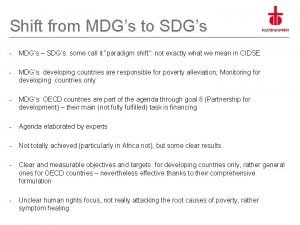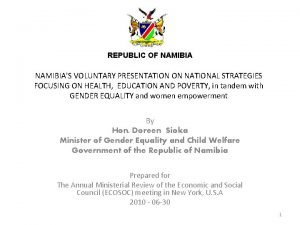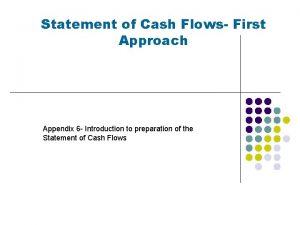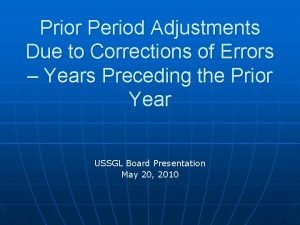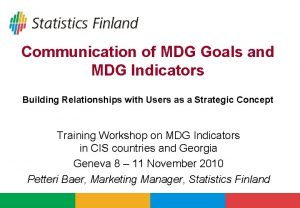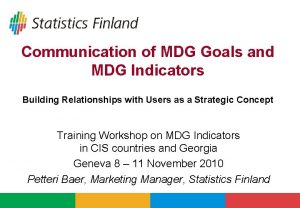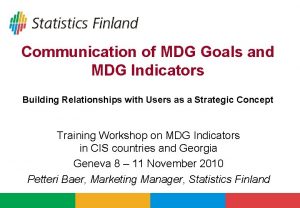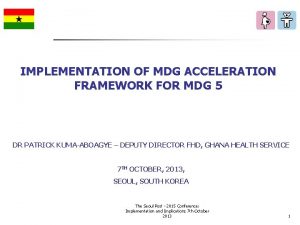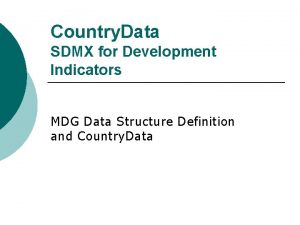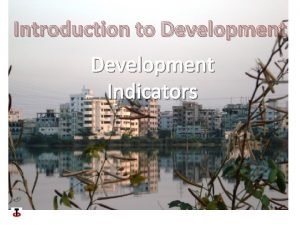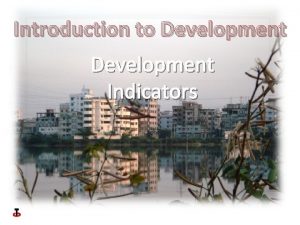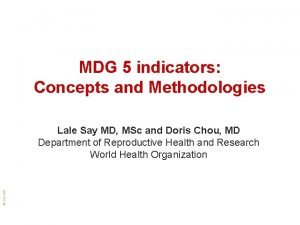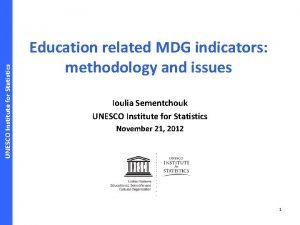Data Sources Assessment and Adjustments for MDG Indicators



















































- Slides: 51

Data Sources, Assessment and Adjustments for MDG Indicators 5. 3, 5. 4 and 5. 6 United Nations Population Division/DESA 8 -12 November, 2010 UNSD/ECE Workshop on MDG Monitoring, Geneva

MDG 5. Improve maternal health • Target 5. B: Achieve, by 2015, universal access to reproductive health – Indicator 5. 3 Adolescent birth rate – Indicator 5. 4 Contraceptive prevalence rate – Indicator 5. 6 Unmet need for family planning

Points addressed per indicator • Definition and methods of computation • Data sources and availability • Data limitations, including comparability • No attempt to provide estimates when country data are not available, except for the estimation of regional and global averages.

Indicator 5. 3 Adolescent birth rate

Indicator 5. 3 Adolescent birth rate Definition • The annual number of births to women 15 to 19 years of age per 1, 000 women in that age group. • Represents the risk of childbearing among adolescent women 15 to 19 years of age. • Also referred to as the age-specific fertility rate for women aged 15 -19.

Indicator 5. 3 Adolescent birth rate Methods of computation • Generally computed as a ratio. – Numerator is the number of live births to women 15 to 19 years of age – Denominator is an estimate of exposure to childbearing by women 15 to 19 years of age. • Numerator and denominator are calculated differently for civil registration, survey and census data.

Indicator 5. 3 Adolescent birth rate Civil registration data • Civil registration data used if registration systems cover 90 per cent or more of all live births. – Numerator is the registered number of live births born to women 15 to 19 years of age during a given year – Denominator is the estimated or enumerated population of women aged 15 to 19.

Indicator 5. 3 Adolescent birth rate Civil registration data • Numerator (number of births): – First priority is data reported by National Statistical Offices to the United Nations Statistical Division (UNSD). – If not available or present problems, data from regional statistical units or directly from National Statistical Offices.

Indicator 5. 3 Adolescent birth rate Civil registration data • Denominator (number of women aged 15 to 19) – First priority is the latest revision of World Population Prospects produced by the UN Population Division (UNPD) in accordance with the recommendation of the 11 th IAEG meeting on MDG indicators. – In cases where the numerator does not cover the complete de facto population, an alternative appropriate population estimate is used if available.

Indicator 5. 3 Adolescent birth rate Civil registration data • When either the numerator or denominator is missing, the direct estimate of the rate produced by the National Statistics Office is used. • When the numerator and denominator come from two different sources, they are listed in that order.

Indicator 5. 3 Adolescent birth rate Survey or census data • Household survey or census data used if no civil registration system or where system coverage is lower than 90 per cent of all live births. – Numerator is births to women that were 15 to 19 years of age at the time of the birth during a reference period before the interview. – Denominator is person-years lived between the ages of 15 and 19 by the interviewed women during the same reference period.

Indicator 5. 3 Adolescent birth rate Survey data • Reference period corresponds to the 5 years preceding the survey (whenever possible). • Reported observation year corresponds to the middle of the reference period. • For some surveys, no retrospective birth histories are available and the estimate is based on the date of last birth or the number of births in the 12 months preceding the survey.

Indicator 5. 3 Adolescent birth rate Census data • Census provides both the numerator and the denominator for the rates. • Numerator includes data on date of last birth or the number of births in the 12 months preceding the enumeration. • In some cases, the rates based on censuses are adjusted for underregistration based on indirect methods of estimation. • For some countries with no other reliable data, the own-children method of indirect estimation provides estimates of the adolescent birth rate for a number of years before the census.

Indicator 5. 3 Adolescent birth rate Obtaining data • Civil registration data: – Data on births or the adolescent birth rate obtained from country-reported data from UNSD or regional Statistics Divisions or statistical units (ESCWA, ESCAP, CARICOM, SPC). – Population figures obtained from the last revision of the UNPD World Population Prospects (and only exceptionally from other sources).

Indicator 5. 3 Adolescent birth rate Obtaining survey data • Published reports from Demographic and Health Surveys (DHS), Reproductive Health Surveys (RHS), MICS and other nationally sponsored surveys. • First priority, estimates available in the survey report. • In no reported figure and if microdata available, estimates are produced by UNPD.

Indicator 5. 3 Adolescent birth rate Obtaining census data • First priority, estimates are directly obtained from census reports. Adjusted rates are only used when reported by the National Statistical Office. • In other cases, the adolescent birth rate is computed from tables on births in the preceding 12 months by age of mother, and census population distribution by sex and age.

Indicator 5. 3 Adolescent birth rate Data availability • In the vast majority of countries there are two or more data points available. 1986 or later 2005 or later No data 3 80 One data point 6 51 Two or more data points 215 93 Any data 221 144 ABR -- Number of countries or areas

Indicator 5. 3 Adolescent birth rate Data availability • Time lag between the reference year and the actual production of the data series. • Civil registration: Data have to be distributed by the National Statistical Offices to UNSD or regional offices. • Survey data: – Reference year about 2. 5 years before the survey. – Delay of ~ 1 -3 years between date of interview and release of the survey report.

Indicator 5. 3 Adolescent birth rate Data availability—how recent?

Indicator 5. 3 Adolescent birth rate Data availability by type Number of data points Per cent of data points Number of countries Average number of data points per country 1850 81% 141 13. 1 Census 84 4% 67 1. 3 Survey 318 14% 93 3. 4 Own-children estimate (from census or survey data) 30 1% 4 7. 5 Other 1 0% 1 1 Total 2283 100% 306 7. 5 Record type Vital registration

Indicator 5. 3 Adolescent birth rate Data limitations • Civil registration data: – Completeness of birth registration – Treatment of infants born alive but dead before registration or within the first 24 hours of life – Quality of the reported information relating to age of the mother – Inclusion of births from previous periods. – Population estimates may suffer from limitations connected to age misreporting and coverage (for national estimates of ABR).

Indicator 5. 3 Adolescent birth rate Data limitations • Survey and census data: – Age misreporting – Birth omissions – Misreporting the date of birth of the child – Sampling variability (surveys)

Indicator 5. 3 Adolescent birth rate Data points—which to use? 1. Registration data: UNSD (number of births if vital registration data considered reliable and complete-Table E 04 Live births by age of mother and sex of child) and World Population Prospects (WPP) recent revision (population of women 15 -19) 2. Registration data: National statistics (if data considered reliable and complete) and WPP 3. Registration data: EUROSTAT, CARICOM, ESCWA (if data considered reliable and complete) and WPP 4. National estimates of ABR based on registration data (if data considered to be reliable and complete) 5. Survey data from Demographic and Health Surveys (DHS)—Final report (reference period 0 -4 years before survey)

Indicator 5. 3 Adolescent birth rate Data points—which to use? 5. Survey data from Demographic and Health Survey (DHS) —Preliminary report 6. Survey data from other national surveys 7. Census data from UNSD: Other estimates in E 04 Table (“births in last 12 months before census”) and UNSD (same census for the population of women 15 -19) 8. Census data from all other sources: Adjusted have preference over unadjusted, including research articles 9. Own-children estimate: Both from survey and census data, including research articles

Indicator 5. 3 Adolescent birth rate MDG and national estimate differences • Civil registration data: – Different denominators – Inclusion of births to women under 15 years of age – WPP population estimate vs. other data for denominator

Indicator 5. 3 Adolescent birth rate MDG and national estimate differences • Survey data: – Discrepancies on the dating and the actual figure if a different reference period is being used (3 year vs. 5 year) – For countries where data is scarce, reference periods located more than 5 years before the survey might be used. – Only one source per year and country. Precedence given to survey programme conducted most frequently at country level, other survey programmes using retrospective birth histories, census and other surveys (in that order).

Indicator 5. 4 Contraceptive prevalence rate

Indicator 5. 4 Contraceptive prevalence Definition • The percentage of women married or inunion aged 15 to 49 who are currently using, or whose sexual partner is using, at least one method of contraception, regardless of the method used.

Indicator 5. 4 Contraceptive prevalence Definition: Methods • Any use, “modern method” use and condom • Modern methods include female and male sterilization, oral hormonal pills, the intra-uterine device (IUD), the male condom, injectables, the implant (including Norplant), vaginal barrier methods, the female condom and emergency contraception. • Traditional methods include the rhythm (periodic abstinence), withdrawal, lactational amenorrhea method (LAM) and folk methods.

Indicator 5. 4 Contraceptive prevalence Data • Nationally-representative sample survey data • Contraceptive prevalence is measured at the time of interview. • Administrative data sources not used because of difficult comparability

Indicator 5. 4 Contraceptive prevalence Data availability • In the majority of countries there are two or more data points available, but many lack recent data. 1986 or later 2005 or later No data 39 124 One data point 44 82 Two or more data points 141 18 Any data 185 100 CP -- Number of countries or areas

Indicator 5. 4 Contraceptive prevalence Data availability • Time lag of one and four years between date of survey interview and publication of survey report. • When interviews are held in two different years, the latest year is given as the reference year. • On average, the surveys are undertaken every three to five years.

Indicator 5. 4 Contraceptive prevalence Obtaining survey data • Published reports from – Demographic and Health Surveys (DHS) – Reproductive Health Surveys (RHS) – Multiple Indicator Cluster Surveys (MICS) – Fertility and Family Surveys (FFS) – Other nationally sponsored surveys

Indicator 5. 4 Contraceptive prevalence Obtaining survey data • If no accessible published survey report, then other published analytic reports. • If clarification needed, contact made with survey sponsors or authoring organization.

Indicator 5. 4 Contraceptive prevalence Limitations of data comparability • Range of contraceptive methods included • Multi-method use (e. g. , pill and condom) • Characteristics of persons for whom contraceptive prevalence is estimated (base population) – Age range – Sexual activity status – Marital or union status

Indicator 5. 4 Contraceptive prevalence Limitations of data comparability • Time frame to used to assess contraceptive prevalence – Methods used “currently” – Methods used at last sex – Methods used in last (1, 2, 12) months

Indicator 5. 4 Contraceptive prevalence Limitations of data comparability • Probing questions (to ensure respondent understands meaning of different contraceptive methods) • Sampling variability, especially when contraceptive prevalence measured – for a sub-group (according to method, age-group, education level, place of residence) – to analyze trends over time

Indicator 5. 4 Contraceptive prevalence Data point selection • First priority is data on contraceptive use among married or in-union women aged 15 to 49 • If none, then data for next most comparable group (sexually-active women, evermarried women, men and women who are married or in union) • If no data on current use, then data on use at last sexual intercourse or during the previous year.

Indicator 5. 4 Contraceptive prevalence MDG and national estimate differences • Different survey data sources • Survey data versus administrative data • Modifications in the case of known errata in the reported figures • Modern methods do not include LAM or folk methods

Indicator 5. 6 Unmet need for family planning

Indicator 5. 6 Unmet need for FP Definition • Women who are – fecund and sexually active – not using any method of contraception – report not wanting any more children or wanting to delay the next child. • Unmet need is the gap between women's reproductive intentions and their contraceptive behaviour.

Indicator 5. 6 Unmet need for FP Definition • For MDG monitoring, unmet need is expressed as a percentage based on women aged 15 to 49 who are married or in a consensual union. • Measured as total unmet need, for spacing births and for limiting births.

Indicator 5. 6 Unmet need for FP Method of computation • Numerator includes, for women who are married or in consensual union and who are not using any contraceptive method: – Pregnant women whose pregnancies were unwanted or mistimed at the time of conception – Postpartum amenorrheic women who are not using family planning and whose last birth was unwanted or mistimed.

Indicator 5. 6 Unmet need for FP Method of computation • Numerator also includes fecund women who: – Do not want any more children (limit), or – Wish to postpone the birth of a child for at least two years (spacing), or – Do not know when or if they want another child (spacing)

Indicator 5. 6 Unmet need for FP Method of computation • Numerator excludes women who: – Are pregnant or amenorrheic due to contraceptive method failure – Are infecund

Indicator 5. 6 Unmet need for FP Measurement of infecundity • Women are assumed to be infecund if they: – Have been married or in union for five or more years, and – Have not had a birth in past 5 years, and – Are not currently pregnant, and – Have not used contraception in preceding five years, or – Self-report they are infecund, menopausal or had hysterectomy, or – Last menstrual period occurred more than 6 months ago (and they are not pregnant or amenorrheic)

Indicator 5. 6 Unmet need for FP Refinement of measure • Refinements over time have clarified the definition of population of risk. • Changes include: – Combination of a self-reporting and algorithmic approach to identifying infecund women – Modifying the analysis of women unsure of their fertility desires – Defining women whose current pregnancy is due to method failure as lacking unmet need (and instead just needing a better method)

Indicator 5. 6 Unmet need for FP Data • Nationally-representative sample survey data from the DHS, RHS and national surveys that – Are based on similar methodologies – Include detailed questions to identify population at risk • Differences in definition used are flagged with footnotes in the data series.

Indicator 5. 6 Unmet need for FP Data availability • More than half of countries and areas have no data points for unmet need. Unmet need for family planning: Number of countries or areas 1986 or later 2005 or later No data 122 181 One data point 31 42 Two or more data points 71 1 Any data 102 43

Indicator 5. 6 Unmet need for FP Obtaining survey data • If no accessible published survey report, then other published analytic reports. • If clarification needed, contact made with survey sponsors or authoring organization.

Thank you Спасибо
 Why shift from mdg to sdg
Why shift from mdg to sdg Mdg
Mdg Print sources of information
Print sources of information Water resources important
Water resources important Measurements equivalents and adjustments
Measurements equivalents and adjustments Journalizing adjusting entries
Journalizing adjusting entries Data collection secondary data sources
Data collection secondary data sources Grade 10 accounting year end adjustments
Grade 10 accounting year end adjustments Cash flow adjustments
Cash flow adjustments Balance day adjustments examples
Balance day adjustments examples Grade 11 accounting module 1
Grade 11 accounting module 1 Temporary adjustment of levelling
Temporary adjustment of levelling Define social adjustment
Define social adjustment Molly mocha employs one college student every summer
Molly mocha employs one college student every summer Adjustments in accounting grade 10
Adjustments in accounting grade 10 Prior period adjustments are reported in the
Prior period adjustments are reported in the Quotes about adjustments
Quotes about adjustments Final accounts with adjustments
Final accounts with adjustments Two types of adjustments to list or quoted price are
Two types of adjustments to list or quoted price are Credit valuation adjustment example
Credit valuation adjustment example Iron butterfly options adjustments
Iron butterfly options adjustments Dietary adjustments after a gastrectomy are influenced by
Dietary adjustments after a gastrectomy are influenced by Kontinuitetshantering i praktiken
Kontinuitetshantering i praktiken Typiska novell drag
Typiska novell drag Nationell inriktning för artificiell intelligens
Nationell inriktning för artificiell intelligens Vad står k.r.å.k.a.n för
Vad står k.r.å.k.a.n för Varför kallas perioden 1918-1939 för mellankrigstiden?
Varför kallas perioden 1918-1939 för mellankrigstiden? En lathund för arbete med kontinuitetshantering
En lathund för arbete med kontinuitetshantering Särskild löneskatt för pensionskostnader
Särskild löneskatt för pensionskostnader Vilotidsbok
Vilotidsbok Sura för anatom
Sura för anatom Vad är densitet
Vad är densitet Datorkunskap för nybörjare
Datorkunskap för nybörjare Tack för att ni lyssnade bild
Tack för att ni lyssnade bild Mall för debattartikel
Mall för debattartikel För och nackdelar med firo
För och nackdelar med firo Nyckelkompetenser för livslångt lärande
Nyckelkompetenser för livslångt lärande Påbyggnader för flakfordon
Påbyggnader för flakfordon Vätsketryck formel
Vätsketryck formel Offentlig förvaltning
Offentlig förvaltning Jag har nigit för nymånens skära
Jag har nigit för nymånens skära Presentera för publik crossboss
Presentera för publik crossboss Vad är ett minoritetsspråk
Vad är ett minoritetsspråk Vem räknas som jude
Vem räknas som jude Treserva lathund
Treserva lathund Mjälthilus
Mjälthilus Bästa kameran för astrofoto
Bästa kameran för astrofoto Centrum för kunskap och säkerhet
Centrum för kunskap och säkerhet Byggprocessen steg för steg
Byggprocessen steg för steg Mat för idrottare
Mat för idrottare Verktyg för automatisering av utbetalningar
Verktyg för automatisering av utbetalningar Rutin för avvikelsehantering
Rutin för avvikelsehantering
